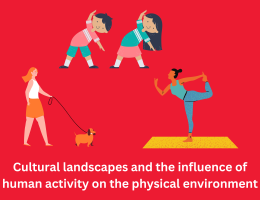
Cultural landscapes and the influence of human activity on the physical environment
- By admin --
- Thursday, 07 Mar, 2024
Introduction:
Cultural landscapes, which over the years replicate the values, beliefs, and practices of many communities, are the outcome of human interaction with the natural surroundings. These landscapes consist of loads of elements, including constructed buildings, agricultural patterns, places of worship, and conventional architectural patterns. The physical surroundings is significantly encouraged via human pastime, which additionally shapes biodiversity, ecological approaches, and land utilization. This article will look at the idea of cultural landscapes and study the approaches wherein human pastime influences the natural international.
Understanding Cultural Landscapes:
Cultural landscapes are the effect of complex relationships among people and their environment in preference to just the outcome of individual acts. They include both fabric such things as systems and monuments as well as immaterial such things as customs and rituals. Cultural landscapes are categorised into numerous kinds, including industrial, agricultural, rural, city, and holy landscapes. These sorts of landscapes constitute specific styles of land use and human interest.
Human Influence on the Physical Environment:
The physical surroundings is substantially impacted with the resource of human interest, which modifies ecosystems and herbal approaches in numerous techniques. Urbanization is a distinguished instance of ways human effect may be determined inside the herbal worldwide because it changes it into a built surroundings with homes, transportation systems, and infrastructure. Natural habitats are invaded by using city sprawl and city growth, which fragments ecosystems and lowers biodiversity.
Agricultural practices have a full-size have an effect on on the bodily surroundings and the formation of cultural landscapes. Terracing, irrigation, and crop rotation are examples of conventional farming techniques that have been used for a while to form the ground to match human necessities. However, soil erosion, water pollutants, and biodiversity loss are effects of present day-day-day agricultural techniques which includes automation, monoculture, and using agrochemicals.
Industrialization has furthermore had a big effect at the bodily surroundings, changing landscapes and contaminating the air, water, and soil via the improvement of factories, mines, and infrastructure. Pollutants from commercial techniques, collectively with greenhouse gases, heavy metals, and perilous chemical materials, visit pot the environment and boost up weather alternate.
Cultural Landscapes as Heritage:
Numerous cultural landscapes are stated as UNESCO World Heritage Sites because of the truth they may be of exquisite cultural, ancient, and aesthetic significance. These places, which embody the Taj Mahal in India, the Great Wall of China, and Machu Picchu in Peru, are valuable as logos of human civilization due to the fact they display great times of human inventiveness and innovation.
Cultural landscapes ought to be managed and preserved at the way to maintain their environmental and cultural relevance.Land-use planning, community involvement, and historic conservation are examples of sustainable improvement techniques which can help in hanging a balance between the want for environmental protection and economic improvement and the renovation of cultural values.
Conclusion:
Strictly speaking, cultural landscapes are the result of the interaction between individuals and their physical environments and also the norms, values and aspirations of many corporations Human play has a profound, transformative impact on the vegetable world biological and vegetable soil in many ways . The marketing of sustainable development, the protection of cultural heritage and the protection of the environment for future generations all depend on knowledge of the relationship between cultural landscapes and their conditions.





